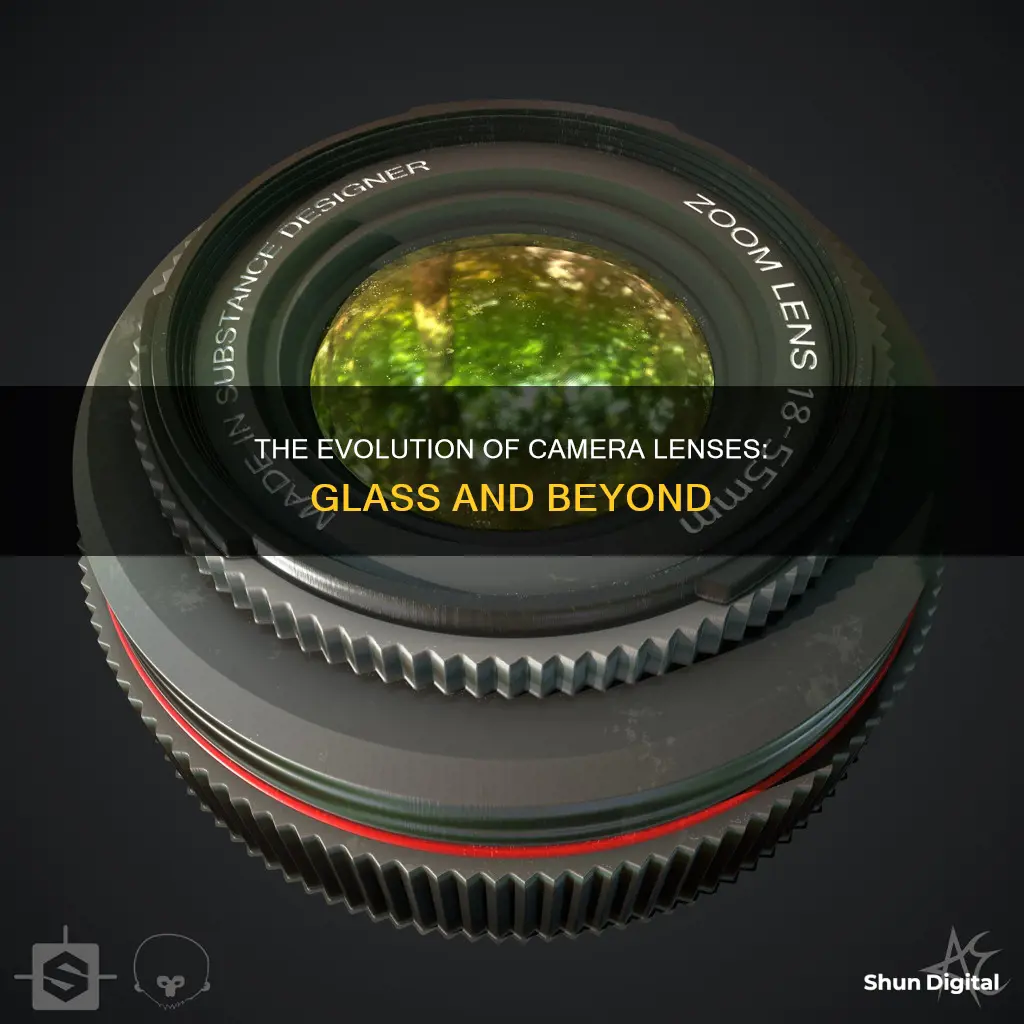
Camera lenses are made from a variety of materials, including glass and plastic. While glass is the preferred choice for lens elements due to its superior optical and mechanical properties, plastic is commonly used in smartphone camera lenses and hybrid glass-plastic lenses. The use of plastic in camera lenses offers advantages such as reduced size, weight, and cost, while glass provides better image quality, durability, and light transmission. The choice between glass and plastic depends on the specific requirements of the lens, such as image quality, size constraints, and cost considerations.
| Characteristics | Values |
|---|---|
| Composition | Optical glass or plastic |
| Glass type | Crown glass, flint glass |
| Plastic type | Polymethyl methacrylate (PMMA), Plexiglas, optical resin |
| Glass properties | Higher refractive index, temperature stability, mechanical strength, variety of coatings |
| Plastic properties | Easier to mould into complex shapes, lower cost, lighter weight |
| Glass advantages | Superior image quality, more durable, less static charge, better light transmission |
| Plastic advantages | Smaller size, suitable for smartphones |
What You'll Learn

Camera lenses are made from optical glass or plastic
Smartphone camera lenses are made almost exclusively of plastic. Plastic lenses are used in smartphones because they can be injection-moulded into complex shapes easily, making it a lot easier to produce ultra-thin aspherical elements than with glass.
Glass is still considered superior to plastic for lens-making in many respects. It has a higher refractive index, temperature stability, mechanical strength, and variety. Glass elements can also have a higher range of coatings applied to them compared to plastic ones. This is due to the high transition temperature of glass.
Plastic lenses are more susceptible to changes in shape due to humidity, which is not ideal for the lens element that light first passes through or the last element before the light hits the camera sensor. This is why most smartphone cameras add a protective layer of gorilla glass or sapphire glass over the outer plastic lens element.
Glass lenses are also more durable and don't easily acquire high static charges that attract dust. They are also better at transmitting light compared to plastic lenses.
GoPro 4 Charger Cord: What Size Do You Need?
You may want to see also

Glass is the preferred choice of material for a lens
Another advantage of glass lenses is their overall strength and resistance to breakage. Glass lenses are less susceptible to scratches and other types of damage compared to plastic lenses. This makes them more durable and longer-lasting, especially in challenging shooting environments. Glass can also withstand the application of multiple coatings, which enhance the lens's performance by reducing reflections and improving light transmission.
The mechanical strength of glass is also higher than that of plastic. This means that glass lenses can maintain their shape and structural integrity, even when subjected to external forces or changes in humidity. Glass lenses are less prone to shape deformation due to humidity, ensuring that the light passing through the lens remains consistent and unaffected.
Additionally, glass offers a wider variety of formulations and optical properties compared to plastic. This versatility allows manufacturers to create lenses with specific characteristics, such as crown glass and flint glass, which have different indices of refraction and dispersion characteristics. By combining multiple glass elements with distinct properties, manufacturers can correct optical flaws and improve image quality.
While plastic lenses have their applications, such as in smartphone cameras where space is limited, glass remains the preferred choice for DSLR and mirrorless camera lenses. Glass provides superior image quality, durability, and light transmission capabilities. It is a key component in achieving the precise results demanded by professional photographers and enthusiasts alike.
Polaroid Camera Battery: Where is it Located?
You may want to see also

Glass has a higher refractive index than plastic
Camera lenses are designed to duplicate the operation of the human eye. They focus light rays by refracting or bending them so that they converge at a common point. The refractive index of a material is a dimensionless number that indicates its light-bending ability. In other words, it determines how much the path of light is bent when it enters a material.
Glass and plastic are both used in the construction of camera lenses. However, glass is generally preferred due to its superior optical properties. One of these properties is its higher refractive index compared to plastic. Glass typically has a refractive index ranging from 1.3 to 1.7, while plastics fall within the range of 1.3 to 1.76. This higher refractive index of glass means that it can bend light more effectively than plastic.
The refractive index of a lens is crucial in determining the quality of the images it produces. A higher refractive index results in a thinner and lighter lens compared to a conventional lens with a lower refractive index. Additionally, lenses with higher refractive indices often offer improved image quality, which is a critical factor for professional photographers.
While plastic lenses are widely used in smartphone cameras due to their compact size and ease of manufacturing, glass remains the material of choice for DSLR and mirrorless camera lenses. The higher refractive index of glass, along with its temperature stability, mechanical strength, and variety of coatings, ensures its dominance in the market for high-quality camera lenses.
Burst Mode: Capturing Fast-Paced Action with Your Camera
You may want to see also

Glass is more durable than plastic
Camera lenses are made of optical glass or plastic. While some lenses are made entirely of glass, others use a combination of glass and plastic.
The durability of glass lenses is further demonstrated by the fact that most smartphone cameras add a protective layer of gorilla glass or sapphire glass over the outer plastic lens element. Glass lenses are less susceptible to static charges that attract dust and are better at transmitting light compared to plastic lenses.
While plastic lenses have improved over the years and are commonly used in smartphone cameras due to their compact size, glass remains the preferred choice for most camera lenses due to its superior durability and optical qualities.
Charging Your Canon Camera Battery: A Step-by-Step Guide
You may want to see also

Plastic lenses are used in smartphones
Camera lenses are designed to mimic the human eye, focusing light rays to transmit colours, sharpness and brightness onto film or a sensor. Lenses are traditionally made from optical glass, but plastic and plastic-hybrid lenses have become more common.
Smartphone camera lenses are almost exclusively made from plastic. This is because plastic can be injection-moulded into complex, ultra-thin shapes, which are small enough to fit into the compact size of a smartphone. Plastic lenses are also cheaper to produce than glass lenses, which require hours of polishing.
However, glass is still considered superior to plastic for lens-making in many ways. Glass has a higher refractive index, temperature stability, strength, and resistance to breakage. Glass can also be coated with a wider range of materials, and these coatings do not degrade as quickly as they do on plastic. Glass is also more durable and less susceptible to static charges that attract dust.
Despite these advantages, plastic lenses are still widely used in smartphones due to the space constraints of the device. Plastic lenses are the only way to achieve the required thinness of the lens.
Understanding Raw Camera Mode: Unlocking Photography Potential
You may want to see also
Frequently asked questions
Yes, camera lenses are made of glass, but not exclusively. Some lenses are made of plastic or a combination of glass and plastic.
Glass is used for camera lenses because it can be shaped to direct light to a camera sensor or film. Different waves of light react differently with certain glass shapes, so careful design is important.
Optical glass is used for camera lenses. It comes in a number of different formulations, such as crown glass and flint glass, which have different optical properties.
Plastic is often used as an alternative to glass in camera lenses, especially in smartphone cameras. Plastic can be injection-moulded into complex shapes, making it easier to produce ultra-thin aspherical elements than with glass.







